|
DEATH-BENEFITS LAW FAILS FIREFIGHTING PILOTSAUGUST 17 -- DENVER, CO: Six summer wildfire deaths in airtanker and helicopter crashes have renewed a debate about a federal law that pays death benefits to the families of many firefighters but excludes others. A report in today's Rocky Mountain News explains that flight crews on airtankers and helicopters get nothing from the Public Safety Officers' Benefits program, which helps the families of law officers, paramedics, and firefighters killed in the line of duty.
 The U.S. Department of Justice has interpreted the language of the 26-year-old law to cover only workers employed by or volunteering for a government agency. Firefighters employed by contract companies on a fire are not covered. About a third of groundpounders are contract employees, and all the flight crews on airtankers and helicopters are. None are eligible for the federal death benefits. The U.S. Department of Justice has interpreted the language of the 26-year-old law to cover only workers employed by or volunteering for a government agency. Firefighters employed by contract companies on a fire are not covered. About a third of groundpounders are contract employees, and all the flight crews on airtankers and helicopters are. None are eligible for the federal death benefits.
Rep. Barbara Cubin, a Wyoming Republican, is floating the idea of insuring contract pilots under the program. "These pilots are basically on the front lines of fighting these fires," her press secretary Joe Milczewski said. Another new bill in California would require any firefighting company signing a contract with the state of California to provide life insurance to its pilots equivalent to that available to a government employee.
California State Assemblyman Dick Dickerson, a Republican from Redding, also is pushing a resolution to add firefighting pilots to the PSOB program. He was struck by the deaths in August 2001 of tanker pilots Larry Groff and Lars Stratte, who were killed when their planes collided as they fought a brushfire.
"It's just amazing what they have to fly through to drop those loads," Dickerson said. "They need that protection that we should give them. In the long run, they save government a lot of money. If you didn't have contract pilots, you'd have to have state employee pilots on the payroll year round, costing much more money than giving death benefits to the pilots."
Connie Hirth of Hirth Air Tankers in Buffalo, Wyoming, is among those fighting to get the program extended to cover aerial firefighters.
"True, the pilots are flying for private contractors," she said, "but they are flying on state or federal land, and they are protecting lives, they're protecting wildlands, they're protecting property."
 Vicki Minor, executive director of the Wildland Firefighter Foundation, is among those in the industry who are pushing for an extension of the program. Vicki Minor, executive director of the Wildland Firefighter Foundation, is among those in the industry who are pushing for an extension of the program.
"It is such an unjust state in our fire community that all firefighters do not have access to those funds," Minor said.
The Wildland Firefighter Foundation provides cash payment support to surviving family members. The Foundation is one of the few available sources of funding for families with emergency needs for expenses. For more information, contact the Foundation staff:
Wildland Firefighter Foundation
1310 Vista Avenue #22
Boise, Idaho 83705
(208)336-2996

NEW FIRES RIP ACROSS OREGONAUGUST 17 -- SUTHERLIN, OR: Fires on the Umpqua and Willamette National Forests are burning hot, growing fast, and putting up serious new smokes visible for miles across the state.
On the Umpqua, the Apple Fire is listed this morning at 1,500 acres. The fire started yesterday and is burning through heavy timber in very steep terrain 21 miles east of Glide near the town of Dry Creek. Extreme fire behavior, torching and crowning runs, and spotting up to one mile have caused problems; the fire has burned intensely in all fuel types. Three campgrounds were evacuated when the fire ran 1,500+ acres in one burning period.
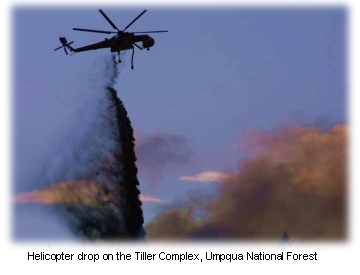 Closure orders are being processed for the North Umpqua Trail and a portion of the North Umpqua River for whitewater rafting. Extreme fire behavior, very low fine fuel and thousand-hour fuel moistures with long-range spotting, poor access, lack of anchor points, steep dissected terrain, and heavy timber are critical problem areas. The fire is projected to double in size and has a high potential for becoming a large Type 1 incident. Closure orders are being processed for the North Umpqua Trail and a portion of the North Umpqua River for whitewater rafting. Extreme fire behavior, very low fine fuel and thousand-hour fuel moistures with long-range spotting, poor access, lack of anchor points, steep dissected terrain, and heavy timber are critical problem areas. The fire is projected to double in size and has a high potential for becoming a large Type 1 incident.
A popular recreation area in the Willamette National Forest remains off limits to the public this weekend, according to the Statesman-Journal, because of a wildfire six miles southeast of Marion Forks. Helped by mild winds yesterday, more than 80 firefighters kept the Mt. Marion Fire from spreading beyond the 100 acres it reached Thursday. Since then, eight popular hiking trails have been closed, as well as Marion Lake and the Eight Lakes Basin. The fire was holding at 100 acres this morning and 25 percent containment; smokejumpers who initially attacked the fire have been configured as a Type 1 crew. Air operations included airtanker and helicopter support to cool hotspots and reinforce firelines. Numerous bug-kill snags remain a safety concern.
The Northwest Coordination Center this morning reported heavy initial attack in the region yesterday, with at least 35 new fires reported. Most of the new fires were the result of strong winds over NE Washington, which downed powerlines and pushed fire through extremely dry fuels. All 12 Fire Danger Analysis Zones in the region have a high probability of a large fire, given an ignition. Active large fire acres total 565,684 in the region, with 10,381 personnel assigned. Sixty-three Type 1 crews are assigned, along with 228 Type 2 crews, 52 helicopters, 408 engines, and more than 2,600 overhead personnel.

FOREST SERVICE JUST SAYS NO TO FIRE-TROLAUGUST 17 -- BOISE, ID: The U.S. Forest Service is abandoning one of its top weapons against wildfires — a retardant mixture that under some circumstances can produce cyanide, according to a KRT Newsfeatures story. Forest Service officials say they're concerned about laboratory tests that show the slurry is a danger to wildlife, and they don't want to take a chance by continuing to use it. Some experts say the slurry — made by Fire-Trol — is safe and necessary for attacks on massive wildfires such as those that have plagued the drought-stricken West.
Laboratory tests show it can be toxic to aquatic life, but the Forest Service will continue using Fire-Trol products until its contract with the company expires in 2004, according to a report by the Daily Camera. Lab tests show that when Fire-Trol brands are exposed to sun and water, they briefly can release small amounts of cyanide that could harm fish. Fire-Trol contends there is no evidence of that outside the laboratory.
"We don't see any evidence that that's happening in the real world," company spokesman Robert Crouch said. But the Forest Service is playing it safe.
"We just determined that it would be prudent not to utilize a product containing that particular chemical," said Alice Forbes, branch chief for equipment and chemicals at the National Interagency Fire Center in Boise, Idaho.

ANOTHER ENGINE INJURY IN OREGONAUGUST 17 -- ROSEBURG, OR: Two firefighters were injured Friday morning when their engine crashed about a mile from Cavitt Creek, according to a report by the Statesman-Journal. The firefighters were en route to the Tiller Complex near Roseburg. Both were taken to Mercy Medical Center in Roseburg, said Barbara Dougan, a spokeswoman at the Tiller fire. Firefighter Ryan Rose was released; Joseph Smith was admitted, but was in good condition, said Dixie Williams, a nursing supervisor. Dougan said the firefighters, from Twisp, Washington, work for the private contractor Smith Creek Engines.
The Roseburg News-Review reported that the rollover happened on Little River Road southeast of Glide. The firefighters had not yet reported to Tiller Complex fire managers at Milo; they were reportedly lost and looking for the base camp.

1,000-ACRE SPOT FIRE BLOOMS ON THE BISCUITAUGUST 17 -- GOLD BEACH, OR: Firefighters this morning were battling a spot fire that took off overnight on the western edge of the Biscuit Fire, according to the Associated Press. Crews on the 419,000-acre complex are hoping for a cooling trend, expected over the weekend, but are concerned that the new spot fire might spread toward homes in two coastal river drainages. "It could go into Chetco or it could go into Pistol River," said Dick Fleishman, fire information officer. "That's a real key piece to get bottled up." Residents along the upper Chetco River and upper Pistol River were put on evacuation alert earlier in the week.
The Biscuit Fire, started by lightning more than a month ago, is 33 percent contained. Firefighters hope to build 112 miles of additional fireline to contain it. About 6,600 firefighters are assigned to the fire; burnouts along the northwest flank have been successful, and similar operations will continue each night during the weekend.

ACCIDENTAL RETARDANT DROP WIPES OUT FISH IN OREGON'S FALL RIVERAUGUST 17 -- BEND, OR: An airtanker on Thursday accidentally dumped about 2,000 gallons of retardant into the Fall River, killing nearly all the fish along a 4-mile stretch of the stream. A report by the Associated Press said retardant also reached the Deschutes River above Sunriver. "The water just went from crystal clear to opaque red," said Steve Avery, a fisherman who was on the Fall River Thursday afternoon. "We saw dead fish, everything from 8-inch hatchery redsides to 24-inch brown trout. It was just awful."
Clair Kunkel, program supervisor for the Oregon Department of Fish & Wildlife, said the drop killed hundreds of hatchery rainbows, native redbands, whitefish, browns, and brookies.
The tanker dropped at least 1,000 gallons and perhaps as much as 2,000 gallons, according to the Bend Bulletin; crews placed absorbent material used to sop up hazardous materials into the river, but it was ineffective against the water-soluble retardant.
Long-term retardants, mixed for delivery to the fire, contain about 85 percent water, 10 percent fertilizer, and 5 percent minor ingredients: color (iron oxide — rust, or fugitive color — fades with exposure to sunlight), thickener (natural gum and clay), corrosion inhibitors, stabilizers, and bactericides. The Fire Chemicals program of the Forest Service's Fire & Aviation Management evaluates and qualifies wildland fire chemicals. They maintain a list of qualified products that meet the Forest Service requirements.
Fire pilots are not allowed to drop over water sources, and an accidental drop such as this one is rare.
"We realize this happened under emergency conditions, close to residential areas," Kunkel said. "Folks were fighting fire in the best way they could at the time. It's an unfortunate accident."

CANADIANS UNIMPRESSED WITH U.S. FIRE FOODAUGUST 17 -- GOLD BEACH, OR: A firefighting crew from Canada, working in 90º heat on southern Oregon's Biscuit Fire, told the Curry Coastal Pilot they don't think much of the chow on the fire.
"The lunches are kinda bad," said Greg Henderson.
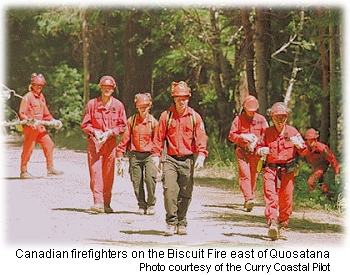 He holds up a sandwich, eight layers of meat spilling out the sides of the white bun. "I'd rather have two or three sandwiches. It's kinda gross like this." He holds up a sandwich, eight layers of meat spilling out the sides of the white bun. "I'd rather have two or three sandwiches. It's kinda gross like this."
Henderson reached into his pack and pulled the rest of his meal out. "Some cookies, Hot Tamales, and a cheesestick. It's not really all that healthy," he said.
Matt Nealis, leader of the crew consisting of 13 Hazelton "Rainmakers" and seven Houston "Thunderdogs," said the firefighters are expected to eat at least 6,000 calories a day. Normal average daily intake for a person not fighting fire is 2,500 calories.
"When I first got here, I worked the (chainsaw) for about 20 minutes and I was pooched," Henderson said. "You have to make sure to eat enough to make it through the 12-hour days."
The heat has been troublesome for firefighters across Oregon the last couple weeks, and some have been treated for dehydration. The Canadians, working a few miles east of Quosatana, though, have recently had a different minor problem with water. They've been cutting brush and trees near a road, and a tanker truck loaded with water runs up and down the road, spraying behind it.
Some of the firefighters grumble that the trucks keep spraying their backpacks.
Although the lunches may not be great, and the firefighters are tired of wet backpacks, they all agree that they want to continue fighting the Biscuit Fire. In fact, most say they'd like to get a bit closer to the fire.
"It's been sort of a slow season up in B.C., so it feels great to be here and helping out on such a big fire," said Dan Burns of the Hazelton crew.

RAIDERS PROTECT COACH'S HOMEAUGUST 17 -- ASHLAND, OR: Linda Olson and her husband Jeff Olson — coach of the Southern Oregon University football team — live on Dead Indian Memorial Road outside of Ashland. According to the Ashland Daily Tidings, the Olsons have received hundreds of phone calls from people offering help and support over the last two days as the East Antelope Fire burned near their home.
Wednesday night it looked as if their home was in direct danger.
 "All of a sudden about 45 Southern Oregon University Raiders drove up with shovels, pickaxes, weedwhackers and rakes," Linda Olson said. "They knew the coach wasn't around (for practice down in Ashland) and they knew why. They gathered guys out of the weight room and drove up in pickups." "All of a sudden about 45 Southern Oregon University Raiders drove up with shovels, pickaxes, weedwhackers and rakes," Linda Olson said. "They knew the coach wasn't around (for practice down in Ashland) and they knew why. They gathered guys out of the weight room and drove up in pickups."
The players worked into the darkness until 10 p.m. Wednesday, then came back early the next morning to build a 40-foot wide firebreak. They removed trees, brush, and grass down to bare earth, hoping to protect their coach's home if the fire advanced.
"It's just incredible what they built," Olson said. "One of our mottos is 'Raider Family,' and I was part of Raider Family Wednesday night and it was awesome."
Coach Olson has taken the Raiders through three consecutive winning seasons. Southern Oregon went 9-2 last season, advanced to the NAIA quarterfinals, and rose to a program-best No. 5 in the final national rankings. They open their 2002 season September 7 against Humboldt State.

FALLER HURT ON EAST ANTELOPE FIREAUGUST 17 -- ASHLAND, OR: A timber faller, 40-year-old Dan Ferrin, was injured Friday morning when a falling limb struck his neck and shoulders, according to a report by the Medford Mail-Tribune. He was flown in a Mercy Flights helicopter to Rogue Valley Medical Center, where he was listed in fair condition.
According to the Ashland Daily Tidings, Oregon Department of Forestry Incident Commander Tim Keith said crews have made good progress, but the fire remains very dangerous. "Thursday was the first day we weren't chasing fire," he said. "We took advantage of the inversion and tied a bunch of our line together in the afternoon. If we can make the same progress today, we'll be right on track."
ODF said early on that the fire was ignited by a spark from a power cable owned by Pacific Power. If Pacific Power is ultimately found to have caused the blaze, it could face a bill of upwards of $4 million for fire suppression costs for the East Antelope Fire. This fire season alone, ODF has spent over $21 million on fire suppression. Half of that money comes from a general fund created by state legislators, while the other half comes from property taxes. "State law requires that through our investigation, whenever a responsible party is identified, we bill them for suppression costs, whether it be from a burn barrel, or a campfire," said ODF fire safety officer Dennis Turco.
The fire was 75 percent contained Friday. Full containment on the 1,886-acre fire was expected Sunday evening, and crews should bring it under control by Tuesday evening.

FLAGSTAFF FIRE CONTAINED AT 1,400 ACRESAUGUST 16 -- FLAGSTAFF, AZ: A fire that ripped over a national monument area through grass and piñon-juniper was contained yesterday, according to an AP report in the Tucson Citizen. The Antelope Fire burned over about 1,200 acres of National Park Service land and another 190 acres of Forest Service land Wednesday evening before dying down as nighttime humidity rose. The Arizona Daily Sun in Flagstaff reported that the Wupatki National Monument includes aboriginal ruins built by people who lived and farmed in the area. Many of the ruins are partially intact, and the monument has been a popular tourist destination in northern Arizona. The fire burned east of Highway 89, just south of Forest Road 545. The fire was called in by a Department of Public Safety officer Wednesday, and more than 40 firefighters were dispatched to fight the blaze.

RIVERSIDE BOY ARRESTED FOR STARTING BRYANT FIRE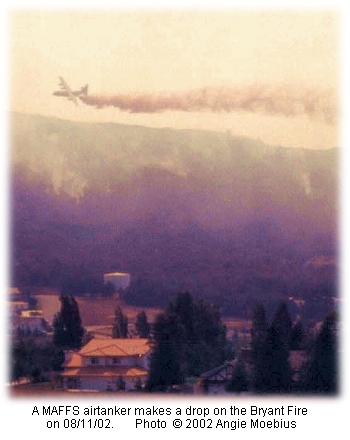 AUGUST 16 -- RIVERSIDE, CA: A 16-year-old boy was arrested Thursday in connection with the investigation into the cause of a 500-acre brush fire last weekend, according to Associated Press reports. AUGUST 16 -- RIVERSIDE, CA: A 16-year-old boy was arrested Thursday in connection with the investigation into the cause of a 500-acre brush fire last weekend, according to Associated Press reports.
The Bryant Fire, which threatened homes in the Calimesa area, began Sunday and was contained after four days at a cost of more than $1.5 million.
It burned four miles northwest of Beaumont, in scrub oak, chaparral, and chamise.
By Monday the fire had 675 firefighters on it, along with 87 engines, three helicopters, and military MAFFS airtankers.

RASH OF FIRES IN NEW YORKAUGUST 16 -- ALBANY, NY: A series of thunderstorms has ignited a dozen forest fires on remote mountaintops in the Eastern Adirondacks, according to the Albany Times-Union, signaling an intense summer wildfire season in New York. To date, 105 acres are burning in a 60-mile-long stretch from Shelving Rock on Lake George to Chesterfield, Essex County, all apparently sparked by lightning strikes in recent weeks. The state Department of Environmental Conservation has prohibited campfires on all forest preserve lands in the Adirondack Park indefinitely and canceled plans to send a third team of 20 forest rangers to battle fires out West. "It's been worse this year," said Capt. John Streiff, the supervisor of forest rangers in the Eastern Adirondacks. "Normally, if everything is lush, we wouldn't be having the fires."

McNALLEY McNALLY FIRE UPDATE
AUGUST 16 -- PORTERVILLE, CA: The fire is still headed northeast and is active north of the Kern River in the Golden Trout Wilderness. Some 550 firefighters are putting in line on the east and west flanks of the fire within the wilderness; there are a number of cabins in these areas and measures for their protection are currently being implemented.
 Mop-up continues in the Baker Peak area. Portions of the Golden Trout Wilderness are closed, including the summit trailhead at the wilderness boundary north to the Sequoia National Park boundary, along the southern boundary of Sequoia National Park, east to the Kern Canyon Ranger Station, south of the trail from Soda Springs (at the Kern River) to Tunnel Meadow, and southeast of the Ramshaw Meadow trail to Strawberry Meadow. Closures are also in place west of Kingfisher Ridge and west of the trail through Fat Cow Meadow and Schaeffer Stringer and the non-wilderness area known as Monache Meadows. Mop-up continues in the Baker Peak area. Portions of the Golden Trout Wilderness are closed, including the summit trailhead at the wilderness boundary north to the Sequoia National Park boundary, along the southern boundary of Sequoia National Park, east to the Kern Canyon Ranger Station, south of the trail from Soda Springs (at the Kern River) to Tunnel Meadow, and southeast of the Ramshaw Meadow trail to Strawberry Meadow. Closures are also in place west of Kingfisher Ridge and west of the trail through Fat Cow Meadow and Schaeffer Stringer and the non-wilderness area known as Monache Meadows.
Some areas have been re-opened for through traffic, including Western Divide Mtn 107 from Ponderosa to Johnsondale, Mtn 99 from Johnsondale to Kernville, and Parker Pass Mtn 50 from California Hot Springs to Johnsondale. Open campgrounds include Long Meadow, Redwood Meadow, Quaking Aspen, Holey Meadow, Camp 3, Hospital Flat, and Headquarters Campground. Reservations can be made for the developed fee campsites by calling the National Recreation Reservation Service at (877)444-6777. Both Trail of 100 Giants and the parking area are now open to visitors. All recreation areas south of Goldledge on Mountain Road 99 are also open.
All areas within the fire closure areas are closed to the public. Dispersed camping is not allowed within the fire closure area except south of Goldledge Campground on Mountain Road 99 and Goldledge Campground remains closed.
The McNally Fire started on July 21 and has burned over 133,000 acres. The fire is about 75 percent contained. NASA's Wildfire Response Team has some excellent images online; the Sequoia National Forest also maintains a fire website complete with photo gallery.

SUPPLY CREEK FIRE OVER 400 ACRESAUGUST 16 -- HOOPA, CA: The Supply Creek #13 Fire, which started on Wednesday afternoon, was initially managed by Linda Szczepanik's Type 2 team, and NorCal Team #1 took over management last night. The fire's estimated at 5 percent containment, with full containment predicted for Monday. According to the Northern California Geographic Area Coordination Center, the fire's burning a half mile west of Highway 96 along Supply Creek near Hoopa. The fire is threatening 450 homes, about 100 commercial buildings, and 50 outbuildings. Nearly 700 personnel are on the fire, including 19 engines, 29 crews, and 5 helicopters. The fire's burning in heavy fuels, and crews will continue building direct handline and putting in contingency lines if the need to go indirect occurs.
The Interagency Fire Forecast and Warning Unit at Redding forecasts smoky but sunny conditions today, with temperatures in the 60s at the coast to near 100º in the inland valleys. Winds should be southwest to northwest at 5-15 mph. The Fire Danger Rating Area maps for California indicate areas of high to very high fire danger.

DOZENS EVACUATED IN PATH OF BIG FISH FIREAUGUST 16 -- TRAPPERS LAKE, CO: A wildfire doubled in size and rushed toward Trappers Lake Thursday, threatening about 50 structures and forcing the evacuation of dozens of visitors and workers. According to the Aspen Daily News, engine crews were protecting the Trappers Lake Lodge, Rio Blanco Ranch, and the Himes Peak campground. "It's huge," said Wayne Krstinich, manager of the store at the Trappers Lake Lodge, looking out on the approaching fire as the last guests evacuated. "All of a sudden it just got out of control. It went over Himes Peak, went over the top."
The Big Fish Fire was sparked by lightning July 18. Fire managers let it burn in the Big Fish Creek drainage, a remote area in the Flat Tops Wilderness where the fire was considered beneficial. The blaze remained at about 50 acres before winds and dry conditions caused it to flare up this week, burning through stands of dead spruce killed in the 1940s and '50s during a spruce beetle outbreak.
On Monday, the fire grew to about 125 acres. Wednesday, it raced to 300 acres, and Thursday it doubled to 600 acres. The fire's on the White River National Forest about 34 miles southwest of Steamboat Springs and 35 miles north of Glenwood Springs. According to the Rocky Mountain Area Coordination Center, Winslow Robertson's overhead team is managing the fire, which is threatening 20 homes, 20 commercial structures, and about 10 outbuildings.

PRETTIEST LAKE I NEVER DID SEEAUGUST 16 -- PROSPECT, OR: Crater Lake might have the clearest water in America, but lately only the luckiest of tourists have been able to see it. The Medford Mail-Tribune reported that Crater Lake will celebrate its centennial as a national park on Aug. 25, but it's been so socked in with wildfire smoke that the lake is often not visible from the rim.
"It’s the best lake I never saw," remarked one disappointed visitor. The smoke has cut the number of and income from visitors to the area, during what is typically the busiest time of the year. Despite the smoke, the Crater Lake Lodge remains full, although the campgrounds have seen fewer guests and some boat tours of the lake have been canceled. The Prospect Hotel, whose guests often frequent the lake about 30 miles away, reports business has been off 25 to 30 percent.
"One day we had one full page of cancellations," said front desk clerk Flo Wright. "We depend on the summer months to get us through the winter months. It’s a sad, sad thing."
There's a web cam at the lodge that's updated every 15 minutes.

EAST ANTELOPE FIRE TRIPLES IN SIZEAUGUST 16 -- ASHLAND, OR: Exceeding all expectations for its potential to spread, the East Antelope Fire exploded in the steep territory around Grizzly Peak east of Ashland. The Ashland Daily Tidings reported that the fire was expected to double in size from 500 to 1,000 acres. But the fire tripled in size on Wednesday. Infrared flights and better mapping caused fire managers to downgrade the 1,800-acre estimate released Wednesday to the 1,550-acre figure this morning.
Airtankers made 17 drops on the fire Tuesday, but thick smoke cut the number to eight on Wednesday. Mark Roy, tanker base manager at Medford, said there are four standing orders for planes at the Biscuit Fire near Grants Pass.
A timber worker based in Grants Pass was injured after being struck by a limb, according to KTVL.com. He was taken to Rogue Valley Medical Center with minor back, shoulder, and arm injuries.

ILLINOIS VALLEY RADIO LISTENERS SAY "THANKS!"AUGUST 16 -- GRANTS PASS, OR: Don't think of radio as a non-visual medium, especially if it's a radio station in southern Oregon's Illinois Valley.
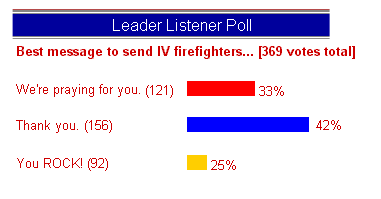 KLDR Radio has kept its listeners up to speed with fire updates throughout the course of the Biscuit Fire, and the station has some pretty fun visuals on its website. One is a photo that listeners and website visitors can guess the content of, and another is a little radio poll asking what Illinois Valley residents should say to firefighters. KLDR Radio has kept its listeners up to speed with fire updates throughout the course of the Biscuit Fire, and the station has some pretty fun visuals on its website. One is a photo that listeners and website visitors can guess the content of, and another is a little radio poll asking what Illinois Valley residents should say to firefighters.
The station announces mandatory evacuations for residents in the fire area, and they have fire information officers on the air live twice each day.
About 30 homes were evacuated three miles south of Agness last night, according to the station's news section, because the fire had burned to within a mile of the neighborhood of Oak Flats.
Fire spokesman Dick Fleishman said the fire was progressing steadily toward the houses. He says the Curry County Sheriff thought it would be safer to evacuate during the day rather than at night. National Guard troops were posted on the roads leading to the communities to keep residents who had evacuated from re-entering.
The fire's now 30 percent contained at 405,660 acres.
More information for Illinois Valley residents is available from KTVL.com

FIRE-SPOTTER PLANE PROMPTS POT BUSTAUGUST 16 -- MEDFORD, OR: The Jackson County Sheriff’s Department late Thursday seized nearly $400,000 worth of marijuana growing on BLM land, according to the Medford Mail-Tribune. A spotter plane identified the marijuana gardens growing in a clearing in northern Jackson County and deputies arrested a 31-year-old transient while he was watering the plants. Deputies confiscated 104 plants from two one-acre parcels.

KANSAS FIREFIGHTER LUCKY TO BE ALIVE AFTER FALL DOWN SLOPEAUGUST 15 -- TILLER, OR: A 50-foot head-first tumble off a steep mountainside sent a firefighting soldier on a helicopter flight to a Medford-area hospital Tuesday. The Roseburg News-Review reported that Sgt. Scott Urban, of Fort Riley, Kansas, was working on the Tiller Complex when he slipped and fell down the slope.
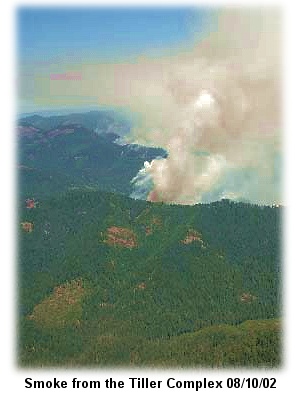 "His doctor says Sgt. Urban is one lucky guy," said Capt. Sherri Reed with Task Force Destroyer, the 540-soldier firefighting contingent assigned to the fire. "He slipped in loose gravel and ash on a nearly 70-degree slope. He is in stable condition." "His doctor says Sgt. Urban is one lucky guy," said Capt. Sherri Reed with Task Force Destroyer, the 540-soldier firefighting contingent assigned to the fire. "He slipped in loose gravel and ash on a nearly 70-degree slope. He is in stable condition."
Urban was part of mop-up operations on the Little Boy and Big Bend fires east of Tiller near the Rogue-Umpqua Divide Wilderness Area. The rest of Urban's unit is being released today, ending a 14-day assignment on the Tiller Complex.
Hart's Type 1 team and U.S. Army Task Force Destroyer (1st Battalion, 5th Field Artillery Regiment) commanded by Lt. Col. David R. Byrn Sr., have been managing this 48,000-acre complex, consisting of eight large and numerous small fires on the Tiller Ranger District and in the Rogue-Umpqua Divide Wilderness Area. Short crown runs, torching, and spotting were observed yesterday in grass, brush and timber. Crews are building indirect and direct attack fireline and conducting burnout operations. Structure protection is in place in Ash Valley.
More than 2,280 firefighters are on the fire, which has run over $20,600,000 in suppression costs to date. Fire managers anticipate that another 1000-3000 acres will burn, because of hot, dry weather on the uncontrolled perimeter on the north and east flanks.

FIND THE ARSON TRUCK, GET A REWARDAUGUST 15 -- PRESCOTT, AZ: Investigators are looking for a pickup truck in connection with the Indian Fire near Prescott in May. The fire burned 1,300 acres and destroyed six homes. According to 12news in Arizona, investigators determined that the fire was human-caused. They are looking for anyone who may have seen a red pickup truck near Indian Creek Road on May 15 around 2:30 p.m. The wildfire was first spotted around that time near Indian Creek Campground. A reward is being offered for information leading to an arrest and conviction regarding the fire. Email 12news if you have information.

OREGON'S BOULDER FIRE BOILS OVER AGAINAUGUST 15 -- TILLER, OR: On Dumont Creek, the sun glared through a rain of light ash and choking smoke Tuesday afternoon as the Boulder Fire boiled over fire lines once again. The Roseburg News-Review reported that another ridge-top fireline had failed 13 miles northeast of Tiller; the Boulder Fire is burning northwest in heavy fuels. Better visibility today for much of Douglas County is the only significant improvement expected; the 48,000-acre Tiller Complex smoked out the county on Tuesday under a strong inversion. Firefighters have been battling heat and dehydration in triple-digit temperatures.
"This thing is like a volcano," said Frank Keeler, division supe on the complex's Boulder Fire. "It's oozing along, not running fast, but it's hard to stop."
Temperatures over 100º and 70-degree slopes in rough terrain have proved challenging for crews on the fire. "It's tough to fight fire in this stuff and hard to predict where to be and what line to pick," Keeler said. "You hope you know what will hold and what won't." Keeler said crews are experiencing respiratory problems and fatigue. One firefighter suffering from dehydration was transported to a Milo fire base on Tuesday afternoon.
Three types of heat stress include heat cramps, heat exhaustion, and heat stroke. Though heat stroke — which can be fatal or result in permanent damage — is easily preventable, it's critical to bring it under control in order to avoid complications.

EAST ANTELOPE FIRE SMOKES OUT ASHLANDAUGUST 15 -- ASHLAND, OR: When the East Antelope Fire blew up, with temperatures in the hundreds, it appeared Ashland had suddenly developed a nearby volcano. The Ashland Daily Tidings reported that a plume of ash and smoke streamed southeast, where it settled by late evening, choking the valley and obscuring the stars. This morning, the smoke continued to shroud the valley. The East Antelope Fire — two miles northwest of Grizzly Peak — scorched 500 acres overnight, and continues to burn today with no estimate of containment or control. Sources at the Oregon Department of Forestry predict that the blaze could double in size today, and could begin moving northeast, fanned by prevailing winds.
The plume was visible from Interstate 5 and Ashland Wednesday afternoon, according to the Medford Mail-Tribune. Fanned by northwest winds, the fire doubled in size within hours, reaching 1,800 acres by nightfall. The fire started Tuesday afternoon when tree limbs rubbed against powerlines, dropping sparks into dry brush. High temperatures, increased power use, and smoky air caused the powerlines to sag into the tree, according to Pacific Power.

SOUTH CAROLINA PLOW OPERATORS DEPLOY SHELTERSAUGUST 15 -- BAYBORO, SC: Three firefighters in rural Horry County deployed shelters on Monday when a fire turned and trapped them. "It was an experience I wouldn't like to have again," said Ed Frinks. He and the other two South Carolina Forestry Commission employees were uninjured, according to The Sun News, and managed to build firebreaks around the 317-acre blaze.
Frinks, Jerry Jernigan, and Matthew Schlaefer found themselves trapped when Frinks noticed the wind changed. "It turned in about three minutes," he said, "and we deployed our fire shelters." Henry Bell, incident commander on the fire, said they were the first employees he has known to use their fire shelters in his 17 years with the Forestry Commission. The fire began Sunday after a debris fire got out of control. Aynor resident Tony Lynn Graham was cited for careless and negligent burning for failing to control the debris fire.

SEAT DAMAGED AT JEFFCOAUGUST 15 -- GOLDEN, CO: A single-engine airtanker taking off with a load of retardant veered off a runway at the Jefferson County Airport Wednesday, according to CNN reports. It damaged its landing gear, but the pilot walked away, said Jefferson County spokesman John Masson. The National Transportation Safety Board, Federal Aviation Administration, and Forest Service were investigating the cause of the incident. The plane was on its way to the Cherry Creek Fire; it had departed from Fort Collins, made one drop, and then landed at Jefferson County Airport to reload.

FIVE FIREFIGHTERS INJURED IN ENGINE ROLLOVER ON OREGON'S BISCUIT FIREAUGUST 14 -- BROOKINGS, OR: Five contract firefighters were involved in a rollover accident on their way to the west flank of the Biscuit Fire, according to Associated Press reports, when the driver of their crew cab pickup apparently fell asleep and ran off U.S. Highway 199. The crew was en route to the incident command post near Brookings when the accident occurred. The engine ran off the road near Rough and Ready Creek outside the community of O'Brien.
It was the second time this summer that firefighters from Ferguson Management Co. of Albany were injured, according to a report in the Salem Statesman-Journal, and a photo published there shows that the engine veered into a drainage ditch, where it hit a culvert and bounced over it. The firefighters were part of a three-truck convoy driving from Salem to fire camp in Brookings; they left Salem about 4 a.m. and stopped for breakfast in Grants Pass before the 8 a.m. wreck.
The firefighters were taken to Three Rivers Hospital in Grants Pass, and according to a hospital spokesman this evening, all five were treated and released.

BISCUIT FIRE BURNS SNOWCAMP LOOKOUTAUGUST 14 -- BROOKINGS, OR: The historic Snow Camp Mountain lookout burned on Monday, according to the Curry Coastal Pilot.  Firefighters tried unsuccessfully to save the lookout by clearing around it and wrapping it in fireproof material. Firefighters tried unsuccessfully to save the lookout by clearing around it and wrapping it in fireproof material.
The lookout, 36 miles northeast of Brookings, was built in 1958. It was a 15-foot by 15-foot cabin-type structure at ground level, located atop Snow Camp Mountain. Since 1990, it has been available to the public for overnight stays.
The Ashland Daily Tidings reported that the lookout, overlooking the Pistol River and the Kalmiopsis Wilderness, was first used to spot fires in 1924, and a spotter stationed there during World War II saw a Japanese airplane that had been launched from a submarine to drop a bomb in a failed attempt to ignite a forest fire. The lookout was retired from service in 1972.
Firefighters were also working Tuesday near the Quail Prairie Mountain lookout, which has so far survived the fire.
The fire was moving west along the Chetco River near Tolman Ranch, and crews were removing brush from roadsides. Firefighters were pulled from firelines and sent to safety zones near the break between Zone 1 (east) and Zone 4 (west) when the fire there spotted over firelines.

FIREFIGHTERS TRY TO KEEP BISCUIT FIRE INSIDE LAWSON CREEK WATERSHEDAUGUST 14 -- GRANTS PASS, OR: Firefighters are gaining ground along the south and east flanks of the Biscuit Fire and are mopping up and burning out strategic locations to prevent further spread. But they're having trouble along the north and west flanks, particularly in the Lawson Creek area south of Agness. The fire's been spotting across firelines there.
Crews are preparing the western ridge of Lawson Creek today in hopes of containing the fire within the watershed boundary. The 390,276-acre fire is burning outside containment lines below Snow Camp Mountain; crews finished a segment of critical fireline there yesterday.
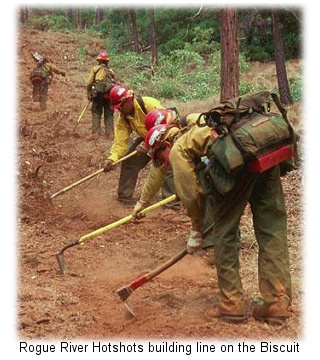 The fire is also burning outside containment lines near Quail Prairie Mountain, but with the help of helicopters yesterday, crews were able to contain some of the fire near Emily Creek. The fire is also burning outside containment lines near Quail Prairie Mountain, but with the help of helicopters yesterday, crews were able to contain some of the fire near Emily Creek.
The entire complex is estimated at 26 percent containment.
Burnout operations were successful yesterday along the southwest flank of the fire between the Chetco River and Long Ridge; all indirect line along the northern perimeter of the fire has been prepared for burnout operations. Firefighters are waiting for fire behavior and weather conditions to improve before they begin.
Smoky conditions yesterday grounded helicopters along the entire west flank, and locations for new helispots are being identified.
The Biscuit Fire — one of the largest in Oregon's history — encompasses most of the Kalmiopsis Wilderness and stretches from 10 miles east of Brookings south into California, east to the Illinois Valley, and north to within a few miles of the Rogue River. The fire is the top priority for the Pacific Northwest Region with 6,410 personnel including members of the Oregon National Guard and firefighters from Canada, Australia, and New Zealand. The Biscuit Fire's joint information center is online at www.biscuitfire.com and includes current maps, fire updates, and a photo gallery.

SATELLITE SHOT FROM 08/13/02

Heat signatures (red) and smoke (light blue haze) are visible in this satellite shot from NOAA's Operational Significant Event Imagery team. The Tiller Complex was 41 percent contained at 44,880 acres yesterday; The Biscuit Fire, at 26 percent containment, was at 390,276 acres. To see a larger image from NOAA, click on the image above.

CHERRY CREEK FIRE NEARLY CONTAINEDAUGUST 14 -- GOLDEN, CO: Firefighters pounded the Cherry Creek Fire yesterday, containing 90 percent of the 1,400-acre blaze despite adverse weather conditions. The Durango Herald reported that full containment is expected by tonight. Retardant and water drops by airtankers and helicopters, and hard work by local fire crews and bulldozers were the two primary factors in beating the blaze, said Ron Klatt, the incident commander. Crews took advantage of plowed fields in the area to stop the fire’s spread. The blaze remained at about 1,400 acres; county officials said the fire was 1,500 acres Monday night, but estimates were revised early Tuesday. The cause of the fire was determined to be lightning that occurred last week. Lightning starts can smolder under the ground or in surface fuels before conditions trigger an ignition days later. About 25 residences and 25 outbuildings were still threatened Tuesday, but only a recreation-style trailer has been lost. The fire’s cost is estimated at $332,000.

OREGON TIMBER HARVEST REACHES NEW LOWAUGUST 14 -- SALEM, OR: The volume of Oregon timber cut in 2001 marks a new low in 12 years of dwindling harvests since the spotted owl was listed under the Endangered Species Act, according to a report in the Statesman-Journal. Last year's harvest was 3.44 billion board feet, down more than 400 million board feet from 2000, according to the Oregon Department of Forestry’s newly released annual harvest report. Federal lands in Oregon recorded the lowest harvest since 1942.
The Medford Mail-Tribune also reported that people at a community forum on Tuesday agreed that Oregon forests desperately need thinning to reduce the threat of severe wildfires. The forum included representatives of the timber industry and environmental groups, along with local government officials; the session was led by U.S. Sen. Gordon Smith of Oregon. Many concurred that thinning younger trees and ladder fuels while leaving larger trees is the solution. But others said the first thing that needed to be thinned is lawsuits brought by environmental groups to halt forest management projects.
"It would not be wise to go in and clean out the mature trees; the problem is in the young ones," said Lou Gold, a former college professor and longtime environmental activist.
The severe fire season is the result of decades of fire suppression, according to Steve Fitzgerald, a silviculturist and associate professor at the Oregon State University Extension Service. An estimated 35 percent of Oregon's forests are at high risk for severe wildfires. "The type of thinning and selective harvesting I'm proposing will need to be different than what was done in the past," he said. Such management could result in less dangerous and less damaging — and less costly — wildfires.
"To do this vital work, we need sustained funding of the National Fire Plan to reinvest in our forests to first stabilize their health and then to improve their resiliency to wildfires in the long term," he said.
Some people get the connection between the record low harvest and the huge wildfires raging across Oregon. "Certainly we have seen a huge buildup of fuels on the federal forests as a result of steadily declining harvests," said ODF's Rod Nichols. "It's ironic that we're having these huge forest fires, and a lot of it is resistance to allowing the forest to be managed properly."
Environmental activists, of course, disagree. "That correlation just doesn't work," said Tim Lillebo with the Oregon Natural Resources Council. "It’s just trying to find a scapegoat for our past logging practices." Nichols said said efforts by the U.S. Forest Service to reduce fuels in forests often are hamstrung by appeals or litigation by environmentalists. "The Forest Service needs to be allowed to manage the forests," he said.
 www.russmo.com

CALIFORNIA SENATE PASSES BILL TO DELAY VOLUNTEER FIRE PROGRAM REQUIREMENTSAUGUST 13 -- RED BLUFF, CA: California Senators have approved AB 2118, an urgent bill that will save volunteer fire programs in rural California until 2005. The bill, according to the Red Bluff Daily News, would postpone the implementation of SB 1207; it attempts to relieve volunteer firefighters of requirements imposed by SB 1207, which imposes what some say are "grievous time constraints for compliance." SB 1207 requires volunteer firefighters to submit to full medical evaluations, additional training requirements, and "fit testing" with breathing apparatus equipment.
"Volunteer firefighters are rural California's first line of defense," said Assemblyman Dick Dickerson of Redding. "It is imperative that they be given adequate time to come into compliance with California law." Volunteer firefighters across the state have commended Dickerson for his action regarding SB 1207, but some call it a much-needed temporary fix of a larger looming problem. The bill is now headed back to the Assembly for a concurrence vote on Thursday.

RED, ORANGE, YELLOW, OR GREEN?AUGUST 13 -- COLORADO SPRINGS, CO: Hundreds of Colorado Springs residents get online every day to see if their house is red, orange, yellow or green.
 A story in the Colorado Springs Gazette says the city's interactive wildland fire map, rating over 44,000 homes, takes as many as 500 hits a day since it was launched two months ago. A story in the Colorado Springs Gazette says the city's interactive wildland fire map, rating over 44,000 homes, takes as many as 500 hits a day since it was launched two months ago.
"I think we've benefited, if that's the right word, from a very active fire season where awareness is high," said David Blankinship, who designed the website for the Colorado Springs Fire Department. "If there's anything good that's come out of these large fires, it's that people are really attuned."
Cathy Prudhomme, FireWise program coordinator for the city, said she gets calls every day from homeowners wanting to know how they can change their rating. When rating each home, firefighters used a 12-point checklist including defensible space items such as roofing and siding materials and the density and location of vegetation.
Blankinship plans upgrades that will explain to homeowners why their house got the rating it did. About 50 homeowners who did work to reduce wildfire risk have asked for a reassessment.
The website's at csfd.springsgov.com and includes sections for homeowners to find their ratings, improve their hazard rating, and reduce wildfire risk. The interactive map shows ratings by parcel, and the site also includes a wildfire mitigation plan and tips on FireWise landscaping.

FIREFIGHTER PILOTS STUCK ON THE GROUNDAUGUST 12 -- FRESNO, CA: If this was a "normal" fire season, pilot Bill Waldman and his P-3A Orion airtanker would be in Montana. Instead, Waldman was in Fresno last week preparing for another attack on the McNally Fire on the Sequoia National Forest. "It's been a bad season for us," said Waldman in a story by Charles McCarthy of the Fresno Bee.
Waldman's plane entered Navy service in 1964. In 1990, the Navy released it for fire airtanker conversion. Waldman was the first pilot to qualify for fire work in the fastest airtanker in the business.
There were seven P3-A airtankers on the active list in mid-June. California Rep. George Radanovich says that excess military planes to bolster the firefighting fleet are needed now. Radanovich blames "what appears to be bureaucratic red tape" for preventing the transfer of newer planes to help combat fires. "It is essential that we use as many airtankers as we can to provide for the safety and support of our men and women who are fighting these fires on the ground," Radanovich said. The story's online from the Fresno Bee.

CALIFORNIA FIREFIGHTERS DISAGREE WITH SENATOR'S PLAN TO PROVIDE YEAR-ROUND AIRTANKERSAUGUST 12 -- LOS ANGELES, CA: California State Sen. Bill Morrow doesn't like it that the California Department of Forestry and Fire Protection pulls its airtankers back to Sacramento for maintenance between December and March. He has written a bill, according to a Los Angeles Times story, that would require CDF to keep two airtankers based in southern California through the winter. But state firefighters say the number of acres burned in the region each winter does not warrant keeping active a crew of 14 people to service, load, and fly the planes. "Our experience is, we're able to put out the fires in the winter with the resources available to us," said Louis Blumberg with CDF. "We think it's not the best use of the state's resources."
Fire officials view Morrow's bill as an unnecessary intrusion by the Legislature; they fear a precedent that would have lawmakers jockeying to dedicate some of the state's 23 airtankers, nine helicopters, and 13 tactical planes to their own districts. "These are statewide assets, and they have to move where they're needed," said Jim Wright, the department's deputy director for fire protection. Morrow's bill, SB 2020, passed the Senate Natural Resources Committee on a 6-2 vote last Tuesday and goes next to the Senate Appropriations Committee.

SHOULD INTERFACE FIRE RESEARCH CHANGE SUPPRESSION TACTICS?AUGUST 12 -- MISSOULA, MT: Researchers investigating the aftermath of major wildfires now think that most burned houses succumb to errant embers, burning after the main fire has swept through, rather than direct affront from the wildfire itself. Jack Cohen, a research scientist at the USFS Fire Sciences Lab in Missoula, thinks it could change the way wildfires in the interface are fought, according to a story published today by kgw.com. "We get the sense that it all happens at once," said Cohen, "that the whole neighborhood explodes into flame, and that's not necessarily the case."
If firefighters can safely wait out a crown fire, they might be able to suppress the subsequent threats to homes in the interface. "You don't need to just throw up your hands and say, 'A crown fire goes through and all the houses go up,'" says Cohen. "This provides an additional opportunity for protection."
"We're trying to ask, 'How can firefighters make the best use of this new knowledge we have to protect life and property?'" says Bret Butler, a research engineer with the Forest Service's Fire Behavior Project in Missoula. At the Rodeo-Chediski Fire in Arizona, roughly four of every five burned homes were surrounded by unburned trees or lawns. The fire lab at Missoula is online at www.firelab.org and a major fire features section on the Rodeo-Chediski Fire is available online from www.azcentral.com/news/specials/wildfires/
[Editor's note: if you try to hunt this fire section up through azcentral.com or azrepublic.com you'll likely give up in frustration. Just use this link.]

AUSSIES DEPLOY TO OREGON FIRELINESAUGUST 12 -- GOLD BEACH, OR: Australia and New Zealand have sent 48 of their most experienced firefighters to the U.S. to help with firefighting efforts.
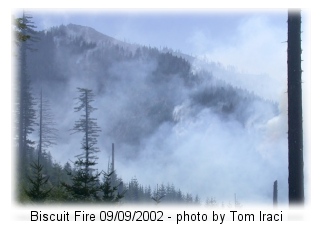 A news.com.au report today noted that the Australasian contingent spent two days in Boise, Idaho, getting up to speed on weather patterns, vegetation, and U.S. firefighting techniques. A news.com.au report today noted that the Australasian contingent spent two days in Boise, Idaho, getting up to speed on weather patterns, vegetation, and U.S. firefighting techniques.
They've been sent to the Biscuit Fire in southwest Oregon. Some of them will assume division supervisor positions; others will manage helicopter bases.
The Biscuit Fire was 376,492 acres this morning and was about 25 percent contained. More than 6,100 people are on the fire.
The northeast corner of the fire (Chrome Ridge) is still creeping to the northeast, and infrared flights are finding hot spots in the interior.
Though the east edge of the fire has cooled considerably, the fire's still active along the northwest edge and the southeast corner near Whiskey Creek.
Crews last night continued line construction and firing operations into the Sugarloaf area. Fireline construction, preparing lines for burnouts, and burning will continue in the northwest corner today in order to secure that flank of the fire to minimize the advance toward Agness.

FLORENCE FIRE NOW THE BISCUIT FIREAUGUST 11 -- GOLD BEACH, OR: The Florence Fire was officially renamed the Biscuit Fire today because of confusion associated with the fire's location.
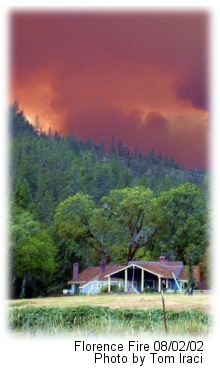 The Florence Fire was named for Florence Creek on the Siskiyou National Forest, but many people thought the fire was near the town of Florence, about 100 miles northwest on Oregon's coast. The Florence Fire was named for Florence Creek on the Siskiyou National Forest, but many people thought the fire was near the town of Florence, about 100 miles northwest on Oregon's coast.
The fire is now estimated at nearly 334,000 acres and is about 25 percent contained. The original Florence Fire started in the Kalmiopsis Wilderness on July 13, and merged with the Sour Biscuit Fire August 7. This fire is the Northwest's top priority, with over 6,100 firefighters on the fire. The Bear Camp Road from Galice to Agness is closed to all users except fire-related traffic and local residents, and the hiking trail through the Rogue River Wild and Scenic Area is closed because of extreme fire danger.
According to a report by the Curry Coastal Pilot, the fire's divided into four administrative zones. Kim Martin, of the Great Basin national Incident Management Team, is in charge of Zone 3 and based near Upper Chetco School. Doug Bright is the Zone 4 IC on the Oregon and California Management Team and is headquartered in Gold Beach.
Wally Bennett's Northern Rockies Team, stationed in Crescent City, California, is in charge of Zone 2. Mike Lohrey's Pacific Northwest Team is in charge of Zone 1 from Lake Selmac.
The Daily Triplicate in Crescent City reported that gusty winds on Thursday pushed the fire across a fireline and prompted the evacuation of Gasquet residents. A fire weather watch was issued for southwest Oregon for strong northeast winds and low humidity; wind speeds this afternoon at Agness are running 14-18 mph.
More than 504,000 acres have burned across public and private lands in Oregon this year. That's 2½ times the 10-year average of 195,000 acres, according to a report in the Eugene Register-Guard. "The increase in fires is quite significant," says Sam Sandberg, head of a Corvallis-based fire and environmental research team for the U.S. Forest Service. "We've had a five-fold to six-fold increase in acres burned in the Northwest over the last decade."

DEPARTMENT OF DEFENSE CRITICIZED FOR NOT SUPPLYING AIRTANKERSAUGUST 11 -- WASHINGTON, DC: After two fatal airtanker crashes in this record-breaking fire season, lawmakers are criticizing the Defense Department for delays in turning over excess aircraft to battle wildfires. According to an Associated Press report, six years after Congress directed the Pentagon to cull its fleet for aircraft that could be converted to firefighting tankers, the first replacement has yet to arrive.
The average age of aircraft in the nation's firefighting fleet is 47 — the oldest was built in 1943, and the newest one, according to the Federal Aviation Administration, is 36 years old. "We badly need to replace some old stuff," said Ed Stone, branch chief of aviation policy for the U.S. Forest Service.
The severity of this year's season has resulted in the airtankers' flying more than double their usual number of hours. Through July 24, the tankers had logged 7,658 hours in the air. In most years, they fly about 5,900 hours annually. The AP story is available online from the Billings Gazette.

FIRE DEBATE COULD GET HOTAUGUST 11 -- WASHINGTON, DC: As wildfires rage across the West, a political conflagration is brewing over environmental laws that protect or, some say, endanger the national forests and people who live nearby. "A heated debate is expected next month when a group of Western senators hopes to increase federal funding both for firefighting and for treating at-risk forests to avoid more seasons like this one," according to columnist Larry Swisher. Politicians accuse environmentalists of having thwarted and delayed fuels reduction projects, and House members have introduced a bill that would suspend the Endangered Species Act and other laws for such projects.
Earlier this month, Sen. Dianne Feinstein of California and Sen. Ron Wyden of Oregon added some bipartisan flavor to an otherwise all-Republican group seeking a new approach to national forest management. According to a story in the Spokane Spokesman-Review, Republicans have said they want to ease the appeals process that environmentalists have used to hold up proposed forest restoration projects on forests across the West.
"The environmental folks still would have a place at the table, but they would no longer be able to veto (forest management plans) by tying things up in court," said Lindsay Nothern, spokesman for Sen. Michael Crapo of Idaho.
"The obstructionism of some environmental extremists is putting homes, businesses, wildlife habitat, water and air quality all at great risk," says Arizona Gov. Jane Hull. "Communities in and around Flagstaff, Prescott, Mount Graham, and others around the state have been achieving public consensus on thinning projects for years, only to have extremist groups file last-minute appeals halting the process and leaving those communities in peril."
The green groups claim senators are planning their own "anti-environmental rider" to the annual appropriations bill for the Forest Service and Department of Interior. Swisher's column is online courtesy of the Eugene Register-Guard, and Gov. Hull's comments are on the Arizona Daily Star website.

GROUNDING AIRTANKERS COSTLYJULY 30 -- DENVER, CO: The cost of grounding nine airtankers is averaging about $34,000 per day, according to an Associated Press report, because the Forest Service is obligated under contract to pay daily availability rates on the grounded tankers. Five C-130As and four PB4Y-2s were grounded after two fatal crashes on fires in the last two months. Tony Kern, USFS assistant director for aviation, said the agency is committed to safety. "Until we're able to determine that there's a fixable problem or that the problem does not relate to the rest of the fleet," he said, "the aircraft will not fly for our missions."
A nandotimes.com report noted that some problems with the fleet were discovered during routine systems checks or between-flight maintenance.
But others weren't, like the two episodes in which pilots and mechanics discovered cracked wings after they saw fuel spilling onto the tarmac. In dozens of other cases, troubles occurred in the air — a situation that often forced airtanker pilots to jettison loads. The realities facing a fleet of planes built in the 1940s, '50s and early '60s have helped fuel a debate about whether the time has come to replace the nation's airtanker fleet with modern aircraft. The sfgate.com story is online, and Kevin Vaughan's report is online courtesy of nandotimes.com

FIRE BOSSES IN SHORT SUPPLYJULY 24 -- BOISE, IDAHO: In the middle of July, according to a report by National Public Radio, more than 4,000 fire bosses — helicopter managers, engine and dozer bosses, incident commanders and other overhead — were mobilizing 15,000 firefighters in the Western United States. 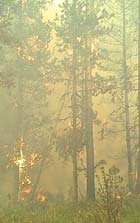 Don Smurthwaite at the National Interagency Fire Center (NIFC) said that for some of the key fire management positions, the agencies have lost 20 percent to 50 percent of qualified personnel between 1995 and 2000. Don Smurthwaite at the National Interagency Fire Center (NIFC) said that for some of the key fire management positions, the agencies have lost 20 percent to 50 percent of qualified personnel between 1995 and 2000.
This is nothing new. During the fire season of 2000, overhead personnel were imported from Australia and Canada, shoring up the numbers of managers needed to direct the efforts of ground troops fighting fires. During the 1994 season, retired federal fire supervisors were brought back to the firelines to help deal with the numbers and severity of that year's fires.
The story's available online from NPR.

COLORADO RESIDENT DONATES BIRTHDAY TO FIREFIGHTER FUNDJULY 04 -- COLORADO SPRINGS, CO: The Wildland Firefighter Foundation received a letter today from Mike Lohrey's incident management team explaining the donation made to the Firefighter Fund by a Colorado Springs resident named Chris Rothenbury. He wanted to show his support and empathy for all wildland firefighters, because he'd been listening to and reading stories of firefighters from across the country who traveled great distances to fight the Hayman Fire.
On his seventh birthday, instead of receiving the usual mix of cards and gifts, he asked that all his friends and family make donations in memory of all heroic firefighters across the country. The letter from Lohrey's team is online here.
Looking for something specific? Search this site:
|
| 


 The U.S. Department of Justice has interpreted the language of the 26-year-old law to cover only workers employed by or volunteering for a government agency. Firefighters employed by contract companies on a fire are not covered. About a third of groundpounders are contract employees, and all the flight crews on airtankers and helicopters are. None are eligible for the federal death benefits.
The U.S. Department of Justice has interpreted the language of the 26-year-old law to cover only workers employed by or volunteering for a government agency. Firefighters employed by contract companies on a fire are not covered. About a third of groundpounders are contract employees, and all the flight crews on airtankers and helicopters are. None are eligible for the federal death benefits.
 Closure orders are being processed for the North Umpqua Trail and a portion of the North Umpqua River for whitewater rafting. Extreme fire behavior, very low fine fuel and thousand-hour fuel moistures with long-range spotting, poor access, lack of anchor points, steep dissected terrain, and heavy timber are critical problem areas. The fire is projected to double in size and has a high potential for becoming a large Type 1 incident.
Closure orders are being processed for the North Umpqua Trail and a portion of the North Umpqua River for whitewater rafting. Extreme fire behavior, very low fine fuel and thousand-hour fuel moistures with long-range spotting, poor access, lack of anchor points, steep dissected terrain, and heavy timber are critical problem areas. The fire is projected to double in size and has a high potential for becoming a large Type 1 incident.
 He holds up a sandwich, eight layers of meat spilling out the sides of the white bun. "I'd rather have two or three sandwiches. It's kinda gross like this."
He holds up a sandwich, eight layers of meat spilling out the sides of the white bun. "I'd rather have two or three sandwiches. It's kinda gross like this."

 AUGUST 16 -- RIVERSIDE, CA: A 16-year-old boy was arrested Thursday in connection with the investigation into the cause of a 500-acre brush fire last weekend, according to
AUGUST 16 -- RIVERSIDE, CA: A 16-year-old boy was arrested Thursday in connection with the investigation into the cause of a 500-acre brush fire last weekend, according to  Mop-up continues in the Baker Peak area. Portions of the Golden Trout Wilderness are closed, including the summit trailhead at the wilderness boundary north to the Sequoia National Park boundary, along the southern boundary of Sequoia National Park, east to the Kern Canyon Ranger Station, south of the trail from Soda Springs (at the Kern River) to Tunnel Meadow, and southeast of the Ramshaw Meadow trail to Strawberry Meadow. Closures are also in place west of Kingfisher Ridge and west of the trail through Fat Cow Meadow and Schaeffer Stringer and the non-wilderness area known as Monache Meadows.
Mop-up continues in the Baker Peak area. Portions of the Golden Trout Wilderness are closed, including the summit trailhead at the wilderness boundary north to the Sequoia National Park boundary, along the southern boundary of Sequoia National Park, east to the Kern Canyon Ranger Station, south of the trail from Soda Springs (at the Kern River) to Tunnel Meadow, and southeast of the Ramshaw Meadow trail to Strawberry Meadow. Closures are also in place west of Kingfisher Ridge and west of the trail through Fat Cow Meadow and Schaeffer Stringer and the non-wilderness area known as Monache Meadows.
 KLDR Radio has kept its listeners up to speed with fire updates throughout the course of the Biscuit Fire, and the station has some pretty fun visuals on its website. One is a photo that listeners and website visitors can guess the content of, and another is a little radio poll asking what Illinois Valley residents should say to firefighters.
KLDR Radio has kept its listeners up to speed with fire updates throughout the course of the Biscuit Fire, and the station has some pretty fun visuals on its website. One is a photo that listeners and website visitors can guess the content of, and another is a little radio poll asking what Illinois Valley residents should say to firefighters.
 "His doctor says Sgt. Urban is one lucky guy," said Capt. Sherri Reed with Task Force Destroyer, the 540-soldier firefighting contingent assigned to the fire. "He slipped in loose gravel and ash on a nearly 70-degree slope. He is in stable condition."
"His doctor says Sgt. Urban is one lucky guy," said Capt. Sherri Reed with Task Force Destroyer, the 540-soldier firefighting contingent assigned to the fire. "He slipped in loose gravel and ash on a nearly 70-degree slope. He is in stable condition."
 Firefighters tried unsuccessfully to save the lookout by clearing around it and wrapping it in fireproof material.
Firefighters tried unsuccessfully to save the lookout by clearing around it and wrapping it in fireproof material.
 The fire is also burning outside containment lines near Quail Prairie Mountain, but with the help of helicopters yesterday, crews were able to contain some of the fire near Emily Creek.
The fire is also burning outside containment lines near Quail Prairie Mountain, but with the help of helicopters yesterday, crews were able to contain some of the fire near Emily Creek.


 A story in the
A story in the  A
A  The Florence Fire was named for Florence Creek on the Siskiyou National Forest, but many people thought the fire was near the town of Florence, about 100 miles northwest on Oregon's coast.
The Florence Fire was named for Florence Creek on the Siskiyou National Forest, but many people thought the fire was near the town of Florence, about 100 miles northwest on Oregon's coast.
 Don Smurthwaite at the National Interagency Fire Center (NIFC) said that for some of the key fire management positions, the agencies have lost 20 percent to 50 percent of qualified personnel between 1995 and 2000.
Don Smurthwaite at the National Interagency Fire Center (NIFC) said that for some of the key fire management positions, the agencies have lost 20 percent to 50 percent of qualified personnel between 1995 and 2000.